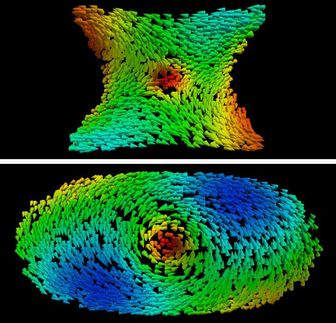Complex materials can self-organize into circuits, may form basis for multifunction chips
Researchers studying the behavior of nanoscale materials at the Department of Energy’s Oak Ridge National Laboratory have uncovered remarkable behavior that could advance microprocessors beyond today’s silicon-based chips.

An ORNL study found that complex oxide materials can self-organize into electrical circuits, which creates the possibility for new types of computer chips. An ORNL study found that complex oxide materials can self-organize into electrical circuits, which creates the possibility for new types of computer chips.
ORNL
The study, featured on the cover of Advanced Electronic Materials, shows that a single crystal complex oxide material, when confined to micro- and nanoscales, can act like a multi-component electrical circuit. This behavior stems from an unusual feature of certain complex oxides called phase separation, in which tiny regions in the material exhibit vastly different electronic and magnetic properties.
It means individual nanoscale regions in complex oxide materials can behave as self-organized circuit elements, which could support new multifunctional types of computing architectures.
“Within a single piece of material, there are coexisting pockets of different magnetic and/or electronic behaviors,” said ORNL’s Zac Ward, the study’s corresponding author. “What was interesting in this study was that we found we can use those phases to act like circuit elements. The fact that it is possible to also move these elements around offers the intriguing opportunity of creating rewritable circuitry in the material.”
Because the phases respond to both magnetic and electrical fields, the material can be controlled in multiple ways, which creates the possibility for new types of computer chips.
“It’s a new way of thinking about electronics, where you don’t just have electrical fields switching off and on for your bits,” Ward said. “This is not going for raw power. It’s looking to explore completely different approaches towards multifunctional architectures where integration of multiple outside stimuli can be done in a single material.”
As the computing industry looks to move past the limits of silicon-based chips, the ORNL proof-of-principle experiment shows that phase separated materials could be a way beyond the “one-chip-fits-all” approach. Unlike a chip that performs only one role, a multifunctional chip could handle several inputs and outputs that are tailored to the needs of a specific application.
“Typically you would need to link several different components together on a computer board if you wanted access to multiple outside senses,” Ward said. “One big difference in our work is that we show certain complex materials already have these components built in, which may cut down on size and power requirements.”
The researchers demonstrated their approach on a material called LPCMO, but Ward notes that other phase-separated materials have different properties that engineers could tap into.
“The new approach aims to increase performance by developing hardware around intended applications,” he said. “This means that materials and architectures driving supercomputers, desktops, and smart phones, which each have very different needs, would no longer be forced to follow a one-chip-fits-all approach.”
Original publication
Other news from the department science

Get the chemical industry in your inbox
By submitting this form you agree that LUMITOS AG will send you the newsletter(s) selected above by email. Your data will not be passed on to third parties. Your data will be stored and processed in accordance with our data protection regulations. LUMITOS may contact you by email for the purpose of advertising or market and opinion surveys. You can revoke your consent at any time without giving reasons to LUMITOS AG, Ernst-Augustin-Str. 2, 12489 Berlin, Germany or by e-mail at revoke@lumitos.com with effect for the future. In addition, each email contains a link to unsubscribe from the corresponding newsletter.




























































